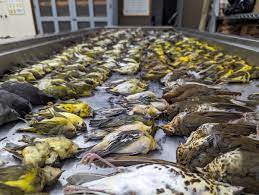Avian Tragedy: Thousands of Birds Collide with McCormick Place in Chicago

On Thursday, October 5th, a heartbreaking incident occurred in Chicago as over 1,000 birds tragically collided with the towering glass structure of McCormick Place. This stunning architectural marvel, known as the largest convention center in North America, proved to be a perilous obstacle for these innocent avian travelers. As they embarked on their journey southward to their wintering grounds, these birds met an untimely demise, leaving both volunteers and conservationists in shock and grief.
A Devastating Day for Avian Conservation
Volunteers dedicated to the cause of avian conservation are still diligently recovering the lifeless bodies of these beautiful creatures within a 1.5-mile radius of McCormick Place. Annette Prince, the director of Chicago Bird Collision Monitors, expressed her dismay, stating, “It’s the tip of an iceberg, but it’s a huge, huge amount of birds we found, both dead and injured.” This catastrophic event marked the highest number of bird strikes ever recorded by the group in a single day.
A Peak in Migration and Unforeseen Tragedy
From late Wednesday, October 4th, through early Thursday, October 5th, an estimated 1.5 million birds were in the airspace over Cook County, home to the sprawling Chicago metropolitan area. Among the casualties were Tennessee warblers, hermit thrushes, American woodcocks, and various other songbird species.
Brendon Samuels, a researcher specializing in bird-window collisions at the University of Western Ontario, noted that not all birds that collide with windows leave behind a body. Some continue flying, albeit seriously injured, ultimately succumbing within hours. The full extent of the tragedy would only become evident as diligent individuals continued to collect birds throughout downtown Chicago in the days that followed.
Factors Behind Avian Collisions
Mass bird fatalities concentrated in a small geographical area are typically associated with peak migration periods in both spring and fall. Adverse weather conditions such as opposing winds, rain, and fog can disorient migrating birds. Moreover, light pollution from urban centers can draw them in and trap them amidst deadly structures.
Bryan Lenz at the American Bird Conservancy emphasizes that wherever there is glass, there will be birds colliding with windows. Shockingly, up to a billion birds meet their end due to such collisions annually. In the case of Chicago, these unfortunate victims were likely en route from Canada to their winter destinations in South and Central America.
The Invaluable Role of Birds in Ecosystems
Birds play an indispensable role in ecosystems, providing essential services with tangible economic value. In areas ravaged by major wildfires, returning birds can disperse seeds and facilitate forest regeneration. The rise in global temperatures has led to increased insect populations, and birds that prey on them help mitigate threats to humans and food systems.
Chicago’s Light Pollution: A Grave Peril
Among all cities in the United States, Chicago’s light pollution poses the gravest risk to migrating birds. One effective measure to reduce bird fatalities is the simple act of turning off building lights. A 2021 study conducted at McCormick Place, the very site of Thursday’s tragedy, revealed that dimming half the lights in large buildings can reduce collisions by six to eleven times. McCormick Place is actively participating in the Lights Out Chicago program, where buildings voluntarily switch off or dim lights at night, provided there are no occupants inside.
However, despite the known hazards, little action has been taken to address this ongoing issue. Annette Prince asserts, “It’s a known hazard, and yet we still can’t see action being taken about it.”
Visual Markers and Legislation for Bird Safety
One promising solution lies in incorporating visual markers like dots or patterns on window glass to break up reflections. This allows birds to recognize whether there is a safe passage for them to fly through. In 2020, Chicago approved a bird-friendly design ordinance, which has yet to take effect. In 2021, Illinois Governor JB Pritzker signed the Bird Safe Buildings Act, requiring bird-friendly design elements to be integrated into the construction and renovation of state-owned buildings in the state.
Brendon Samuels emphasizes that there are already viable solutions available, but they need to be implemented through policy changes. Retrofits, tax credits for environmentally friendly initiatives, and bird-friendly window modifications can serve as cost-effective measures to protect our avian companions.
In conclusion, the tragic incident at McCormick Place serves as a poignant reminder of the urgent need to address the threats posed by glass structures to migrating birds. It is incumbent upon us to take proactive measures, from reducing light pollution to implementing bird-friendly design standards, to ensure the safety and conservation of these magnificent creatures. Our actions today will have a profound impact on the future of avian populations and the ecosystems they support.





